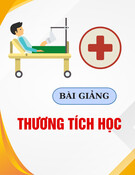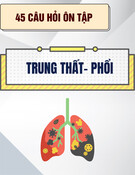
Can Tho Journal of Medicine and Pharmacy 9(5) (2023)
85
Pharmacy in 2013-2014, Good thesis General practitioner, Can Tho University of Medicine and
Pharmacy.
9. Balthazar E J, Birnbaum B A (1994), Acute appendicitis: CT and US correlation in 100 patients,
Radiology, 190(1), pp.31-35.
(Received: 09/02/2023 – Accepted: 13/3/2023)
A STUDY ON RISK FACTORS OF TOXOCARA SEROPOSITIVITY
PREVALENCE AND THE RESULTS OF TOXOCARIASIS TREATMENT
WITH ORAL ALBENDAZOL IN CHRONIC URTICARIA
AT CAN THO DERMATO-VENEREOLOGY HOSPITAL IN 2021
Lac Thi Kim Ngan*, Quach Ngoc Linh, Nguyen Thi Thuy Trang,
Pham Thanh Thao, Huynh Van Ba
Can Tho University of Medicine and Pharmacy
*Corresponding author: ltkngan@ctump.edu.vn
ABSTRACT
Background: Chronic urticaria (CU) is defined by recurrent episodes lasting for six weeks
or more and generally characterized by the sudden appearance of hives (wheal), angioedema or
both. Most are idiopathic, however, one of the causes of chronic urticaria can be parasitic infection,
especially Toxocariasis. Albendazol is used as a treatment for Toxocariasis. Therefore, the detection
of causes, risk factors and specific treatment of the causes helps to solve chronic urticaria.
Objectives: (1) To determine of Toxocara seropositivity in patients with chronic urticaria and
identify the risk factors for toxocariasis; (2) To evaluate the results of oral albendazol in the
treatment of toxocariasis in chronic urticatia. Materials and Method: A descriptive cross-sectional
study of 66 chronic urticaria patients who had the result of serology for Toxocara. Results: The
seroprevalence of Toxocaraiasis in this population was 19.7%. Factors such as a history of
consuming the raw vegetables, raising dogs and cats habit or soil-contacting frequently were at
higher risk of toxocariasis in patients with chronic urticaria. Clinical symptoms such as itching and
hives in patients were significantly reduced. 30.8% of patients had ELISA results (-) after 3 months
of completing treatment; 23.07% of patients had liver dysfunction; and 15.4% of patients reported
side effects of epigastric pain or digestive disorders during treatment. Conclusion: The
seroprevalence of Toxocaraiasis in this population was 19.7%. Several factors have been identified
to be associated with Toxocara seropositivity. Albendazol in the treatment of Toxocara infections is
highly effective and relatively safe.
Key words: Chronic urticaria; Toxocara; Toxocariasis
I. INTRODUCTION
Urticaria is a common disorder, with a prevalence of approximately 15-25 percent
in the general population. Urticaria is traditionally classified into acute and chronic urticaria.
Chronic urticaria (CU) is defined by recurrent episodes lasting for six weeks or more and
generally characterized by the sudden appearance of hives (wheal), angioedema or both [3].
CU only affects 2-3 percent of individuals but it has a significant impact on quality of life [4]. Most
are idiopathic, however, one of the causes of chronic urticaria can be parasitic infection.






























